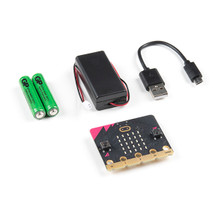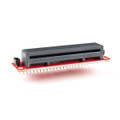 Loading... Please wait...
Loading... Please wait...Categories
- 3D Filament
- Laser Parts
- 3D Printers
- 3D Printer Parts
- Microcontrollers and FPGA
- Shields and daughter boards
- Official Arduino
- Batteries
- Cases and Enclosures
- Cables and Connectors
- CNC
- Components
- Digi XBee
- Displays
- Electronic Brick
- Kits
- Laser Cutters
- LEDs
- Micro:bit
- Motors
- Neodymium Magnets
- Power Supply and Adapter
- Python
- Raspberry Pi
- RFID
- Robotics
- Sensors
- Soldering Equipment
- Tools
- Wearables
- Wireless

- Home
- Microcontrollers and FPGA
- micro:bit v2 Go Bundle
Product Description
Meet the new BBC micro:bit v2 - Upgraded with a powerful new processor that has tons more capability and also adds more sensing with a new speaker and microphone!
The latest micro:bit will fit right into your existing lessons and materials; all the existing MakeCode blocks and MicroPython code will work in the same way as they do on the original micro:bit. More features, including easy ways to take AI and ML into the classroom, will be released throughout 2021.
The BBC micro:bit v2 is a pocket-sized computer that lets you get creative with digital technology. Each order contains just the micro:bit v2 board. You can code, customize and control your micro:bit from anywhere! You can use your micro:bit for all sorts of unique creations, from robots to musical instruments and more. At half the size of a credit card, you will be surprised at the amount of hardware each board is equipped with, including 25 red LED lights that can flash messages. There are two programmable tactile buttons, and a touch sensitive logo that can be used to control games or pause and skip songs on a playlist. The micro:bit can even detect motion and tell you which direction you’re heading. It can also use Bluetooth Low Energy (BLE 5.0) to interact with other devices and the Internet.
This micro:bit v2 Go Bundle provides you with everything you need to get hooked up and powered. This kit includes the micro:bit v2 a short USB cable, a AAA battery holder and AAA batteries. Also inside the Go Bundle you will find a Quick Start Guide with four unique ideas to get you started with micro:bit! The Go Bundle is a quick and economical way to get started with the micro:bit.
On the front of the board you will find the 5x5 LED array that you can use as a light sensor, a tiny screen to draw on, display words, numbers and other information, microphone input & LED indicator, two programmable tactile buttons, and the touch sensitive logo! On the back of the board you will find the brains of the micro:bit, a 64 MHz, ARM Cortex-M4 microcontroller with FPU, 512KB Flash, 128KB RAM and a built-in temperature sensor. Additionally, the back of the micro:bit is populated by an accelerometer, compass, MEMS microphone, speaker, and Bluetooth Smart antenna, as well as a microUSB and two-pin JST connector for different power options. Finally, at the bottom of the board you will find 25 gold-tabbed edge pins and five ring connectors (three for digital/analog I/O, two for power and ground) for hooking up external components. The tabs with larger holes can be easily used with alligator clips are now notched fore easier connection to prototype added components quickly.
The micro:bit has even supplied an intuitive mobile app that lets you send your code to your micro:bit over Bluetooth (without using a USB cable). With this app you will be able to interact with your micro:bit on a higher level of accessibility.
Some new features of the board:
- A more powerful Nordic nRF52833 processor, lots more RAM and Flash so MicroPython works a lot better!
- A MEMS microphone, can hear the world around it
- A speaker, provide audio feedback, play tones
- Capacitive touch sensor, the logo now acts as a button you can boop!
- Power saving mode, double click the reset button to enter low power mode.
The micro:bit v2 Bundle includes:
- 1 x BBC micro:bit v2
- 1 x Micro USB cable, 6" end-to-end
- 1 x AAA battery holder
- 2 x AAA battery
Technical Characteristics:
- 64 MHz Arm Cortex-M4 with FPU
- 512KB Flash
- 128KB RAM
- 5x5 Red LED Array
- Two Programmable Buttons, one touch sensitive logo
- MEMS microphone and LED indicator
- Onboard Light, Compass, Accelerometer, Temp Sensors and Speaker
- 2.4 Ghz Micro:bit Radio/BLE 5.0 Smart Antenna
- 25-pin Edge Connector
- 4 dedicated GPIO, PWM, i2c, SPI, and ext. power
- Three Digital/Analog Input/Output Rings
- Two Power Rings --- 3V and GND
- Dedcated I2C bus for peripherals
- MicroUSB Connector (5V)
- JST-PH Battery Connector (Not JST-XH) (3V)
- Power/reset Button with Status LED
- 200 mA available for accessories
- Program with C++, MakeCode, Python, Scratch
Documents:
Warning:
- Only use Zinc or Alkaline batteries with your BBC micro:bit
- Please do not use rechargeable batteries unless you have confirmed the voltage output, as some rechargeable batteries can output a voltage that exceeds the operating range of the micro:bit.














